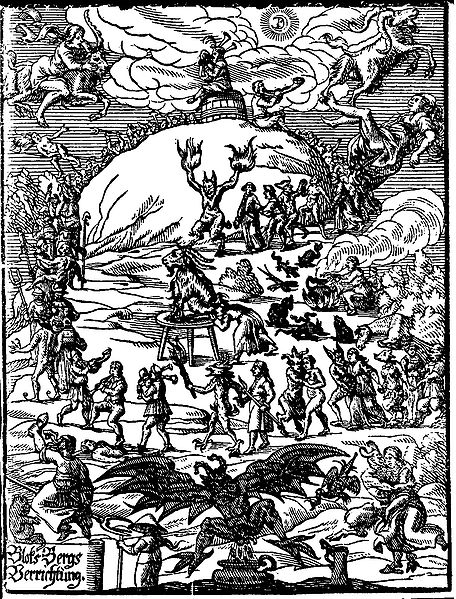
Title illustration of Johannes Praetorius (writer) (de)’ Blocksbergs Verrichtung (1668) depicts the witches’ festival and worship of the Devil commonly imagined to be celebrated on Walpurgis Night.
The current festival is, in most countries that celebrate it, named after the English missionary Saint Walpurga (ca. 710–777/9). As Walpurga was canonized on 1 May (ca. 870), she became associated with Beltane/May Day. The eve of May Day, traditionally celebrated with dancing, came to be known as Walpurgisnacht (“Walpurga’s night”). The name of the holiday is Walpurgisnacht in German and Dutch, Valborgsmässoafton in Swedish, Vappen in Finland Swedish, Vappu in Finnish, Volbriöö, (Walpurgi-öö) in Estonian, Valpurgijos naktis in Lithuanian, Valpurģu nakts or Valpurģi in Latvian, čarodějnice and Valpuržina noc in Czech.
The German term is recorded in 1668 by Johannes Praetorius (writer) as S. Walpurgis Nacht or S. Walpurgis Abend. An earlier mention of Walpurgis and S. Walpurgis Abend is in the 1603 edition of the Calendarium perpetuum of Johann Coler, who also refers to the following day, 1 May, as Jacobi Philippi, feast day of the apostles James the Less and Philip in the Catholic calendar.
The 17th century German tradition of a meeting of sorcerers and witches on May Day is influenced by the descriptions of Witches’ Sabbaths in 15th and 16th century literature.
In Bohemia (known today as the Czech Republic), Walpurgis Night is pálení čarodějnic (“burning of the witches”) or simply čarodějnice (“the witches”) and is the day when winter is ceremonially brought to the end by the burning of rag and straw witches or just broomsticks on bonfires around the country. The festival offers Czechs the chance to eat, drink and be merry around a roaring fire. (The Prague Post has an article about this, with a familiar-looking photo, here.)
In Estonia, Volbriöö is celebrated throughout the night of 30 April and into the early hours of 1 May, where May Day is a public holiday called “Spring Day” (Kevadpüha). Volbriöö is an important and widespread celebration of the arrival of spring in the country. Influenced by German culture, the night originally stood for the gathering and meeting of witches. Modern people still dress up as witches to wander the streets in a carnival-like mood.
From Bram Stoker’s short story, “Dracula’s Guest,” an Englishman (whose name is never mentioned) is on a visit to Munich before leaving for Transylvania. It is Walpurgis Night, and in spite of the hotelier’s warning not to be late coming back, the young man later leaves his carriage and wanders toward the direction of an abandoned “unholy” village. As the carriage departs with the frightened and superstitious driver, a tall and thin stranger scares the horses at the crest of a hill.
In some parts of northern coastal regions of Germany, the custom of lighting huge fires is still kept alive to celebrate the coming of May.

